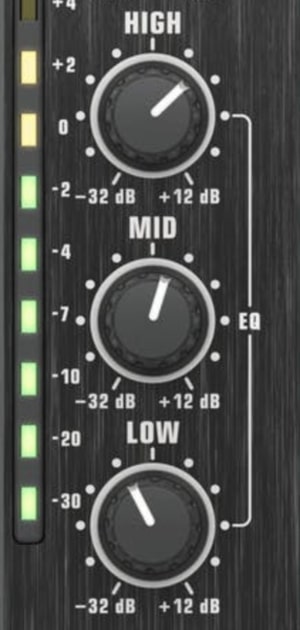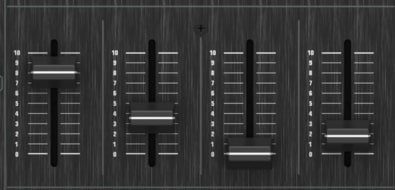
You may of seen DJs on the YouTubes going nuts on the mixer moving around knobs, filters and switches. In some cases DJs are mixing with a fantastic looking background, are mixing progressive house and touching the mixer a billion times. It doesn’t mean they know what they’re doing on the mixer though.
What do DJs do when they turn knobs?
The majority of the time DJs are using EQ switches known as HIGH, MEDIUM and LOW. They are controlling the EQ frequencies to support blending between two tracks. Usually it’s important to not mask to much of the same frequency, especially important for LOW bass EQ as this can make DJ mixes sound muffly and muddy. Other switches / buttons include CUE/PLAY, FX, volume, looping and track selection.
Let’s explore further the controls in which DJs are using on a DJ mixer, whether it be on a dedicated DJ mixer or DJ controller mixer.
EQ Knob Controls

Definition
EQ Controls cut away or boost EQ of a specific range of frequencies for a particular channel on a DJ mixer in which music is playing.
By default each control is set to zero or neutral. DJs 99.9% of the time use these controls to turn down the amount of frequencies being played within the dedicated range. 0.01% of DJs turn up the EQ because they have NO IDEA how to DJ using EQ controls.
- High – controls high frequencies e.g. hihats, cymbals, FX sounds.
- Medium – controls mid range frequencies e.g. pianos, rhodes, vocals, synths.
- Low – controls low end bass frequencies e.g. kick drum, sub bass, bass guitar.
High, Mid or Low of EQ controls are located on each channel on the mixer. You’ll find a minimum of two channels on all DJ mixers, and can be four or more on certain advanced DJ mixers and DJ controllers.
Below is a quick example of how to use the EQ controls, always aim to counteract EQ of the same level e.g. when you blend in the LOW end of one track, aim to blend out (down / negative) of the other simulaneously.
TRIM / GAIN Knobs

The Trim AKA Gain knobs control the amount of signal that is being sent to a particular channel. This then supports and controls the signal amount that goes into the red or stays below the red. Red lights flashing can mean the audio signal is distorted and sounds shite in the speakers or on the recorded DJ mix.
In some cases being in the red is not all bad as DJ software, such as Rekordbox, has a master control the cuts the volume by -3 dBs for example and supports audio from clipping. Which takes the pressure off slightly if you have this setting on when going into the red.
DJs don’t usually use these knobs anywhere as much as the EQ knobs.
CUE/PLAY Buttons

These aren’t knobs, but buttons that DJs press a lot when cueing up a track and then playing a track once beatmatched for example.
Cueing a track means temporarily playing a track to start counting beats to then press the play button “ON THE ONE!”. If a DJ holds down the CUE button the track will play, if a DJ lets go of it, the music stops playing.
Play button can play or pause a track.
Volume Channel Faders

Each channel has a volume fader and are more simple in use. You can put the crossfader into the middle, and then use the channel faders to blend in volume or one channel into the mix.
If a DJ is mixing in more than 2 tracks e.g. 4 tracks in total, then they use all 4 channels to blend in the music using volume faders.
Crossfader

Crossfaders switch from one channel to another. This is the classic way in which a DJ will move from one track to another.
Note, that you can set a different volume curve on the crossfader to support smooth mix transitions or quick sensitive cuts from one track to another. Quick and sharp curves on the crossfader are usually used for scratch DJs to perform scratch routines.
FX Controls

The knob that controls FX is usually the volume for the effect being applied. An ON OFF flases button controls the effects being activated and there’s also either buttons or a knob switch to select through different types of FX to apply.
My favourite are Reverb or Low Cut Echo to transition between tracks in the mix.
Top Tip – with echo or reverb (or any FX) you can increase or decrease the length of an effects cadence for example you can elongate or shorten the rhythm of an echo by using the left of right arrow buttons on your mixer (this is apparent on the DDJ-400 DJ controller that I use anway).
Looping

Looping controls are buttons that you can hit IN button and then OUT button.
This controls when a loop starts by pressing IN, then when you want the loop to end and go back to the start press the OUT button.
There are buttons that can control the length of a loop, usually with a left arrow button or right arrow button.
Top Tip – if you press the OUT button AGAIN after you’ve set the ending of the loop, you can then move the jog wheel anti-clockwise to make the loop shorter making the loop get quicker and quicker until it sounds like a synthesiser. This is a technique that some DJs use to transition between tracks or end their DJ sets.
Here’s a good example of how to use looping in the mix.
Related Questions
What DJs should not do?
Look at the DJ mixer all the time and not look at the crowds reaction to specific music that you’re playing. Drinking too much and partying too much alongside your busy DJ schedule, DJing is a job to a certain extent do you don’t want to burn out.
How do DJs control the crowd?
Being interactive with the crowd is important. This can be done by speaking on the microphone, clapping hands to drive energy for the crowd to copy you, playing vocal music tracks and then cutting out the music for the crowd to sing along instead.
